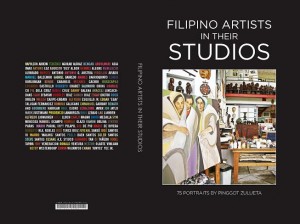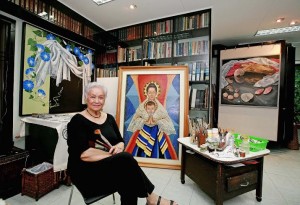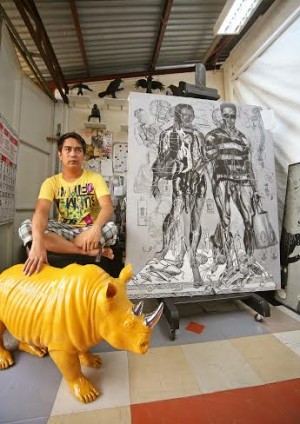
ALTHOUGH they do manually demanding work as much as they perform the intellectual labor of conceptualizing and designing, artists are often likened to writers, thriving in their solitude and “apartness.”
But when one considers that the artist’s studio, unlike the writer’s desk, is really a mess hall and activity room, one gets an idea of the superiority of artists over writers: They flex not only their muscles but also their brain cells; they themselves embody the art they create. The kinetics of the mind become the kinetics of the flesh, and artists themselves are both medium and message.

So if there’s some romance attached to the writer’s desk and library, more romance and rock-star status are accorded to the artist and his atelier. For more serious observers of the art scene, in fact, the studio is sacred space that represents nothing less than Genesis. It is the artist’s personal locus, immediately intimate and profound. It is not only his favorite den and personal geography: It is the landscape of his soul. In a remarkable enterprise all these years, photojournalist José Vinluan Zulueta (no relation to this writer) has been recording Filipino artists in their studios, and the photographic documentation has been published weekly in the Manila Bulletin along with the artists’ profiles (by Ayra Mae de Ocampo, Brian Garcia, Czarina Ong, Hannah Jo Uy, Jacky Lynne Oiga, Johnina Martha Marfa, Pam Brooke-Casin and Vince Lopez).

Now, highlights of those newspaper editions are compiled in the coffee-table book “Filipino Artists in their Studios,” with key articles written by respected writers Isabel de Leon, Barbara Mae Dacanay, Dennis Ladaw and Paul Blanco Zaffaralla. The 75 artists featured in the book are Napoleon Abueva, Federico Aguilar Alcuaz, BenCab, Abdulmari Asia Imao, Arturo Luz, Gus Albor, Hermes Alegre, Nunelucio Alvarado, Marcel Antonio, Antonio Austria, Pandy Aviado, Manuel Baldemor, Gabriel Barredo, Andres Barrioquinto, Elmer Borlongan, Benjie Cabangis, Michael Cacnio, Ross Capili, Eduardo Castrillo, Roberto Chabet, Salvador Ching, Charlie Co, Fil Delacruz, Mideo Cruz, Danny Dalena, Araceli Limcaco-Dans, Igan D’Bayan, Dudley Diaz, Ramon Diaz, Edgar Doctor, Rock Drilon, Imelda Cajipe-Endaya, Alfredo Esquillo Jr., Egai Talusan Fernandez, Romulo Galicano, Emmanuel Garibay, Renato and Guerrero Habulan, Raul Isidro, Geraldine Javier, Jon Jaylo, Mark Justiniani, Prudencio Lamarroza, Raul Lebajo, Lao Lianben, Alfredo Liongoren, Julie Lluch, Carlo Magno, David Medalla, Sym Mendoza, Manuel Ocampo, Romulo Olazo, Ramon Orlina, Lynyrd Paras, Mario Parial, Impy Pilapil, Gig de Pio, Mario de Rivera, Roberto M.A. Robles, José Tence Ruiz, Juvenal Sansó, José Santos III, Mauro Malang Santos, Pablo Baen Santos, Soler Santos, Steve Santos, Cesare A.X. Syjuco, Gerardo Tan, CJ Tanedo, Rodel Tapaya, Roy Veneracion, Ronald Ventura, Nestor Olarte Vinluan, Betsy Westendorp, Edwin Wilwayco and Luis Enano Yee Jr.
Ideal ‘archivist’
Zulueta has the most ideal background to document the artist and his atelier. He himself is one. A Fine Arts graduate of the University of Santo Tomas, he is illustrator, painter and printmaker, having been in group and solo exhibits in the Philippines and Australia. He’s acquainted with the messy rigor required of the visual arts, nowadays obscured if not given short shrift by conceptualism or what may be called “virtualism”: As long as the concept is fancy, ponderous or tendentious, it should pass for art, if not in outright faux dimensions, at least in disingenuous virtual terms.
During his college years, Zulueta was artist and cartoonist of the campus newspaper The Varsitarian, prefiguring somewhat his multiple stints in the news media as cartoonist of the tabloid Abante and the broadsheet Filipino, and now, as photojournalist of the Bulletin.
One suspects therefore that Pinggot insinuates himself to fellow artists’ studios to satisfy his journalistic craving to document and detail the intricate process that starts with inspiration and demiurge and ends in fruition and creation. His “archival” work therefore is both artistic and journalistic.
To be sure, Zulueta uses mainly photography in his journalism, and one is tempted to adopt here Susan Sontag’s polemic “Against Interpretation” and her call on critics and theorists to leave the work alone and not let the intellect exact its revenge on art. If in her other best known essay, “On Photography,” Sontag argues that photography endangers in modern society a “chronic voyeuristic relation” with the world, while fostering in photographers an attitude of anti-intervention, then certainly she would find a kindred advocate in a photojournalist like Pinggot, who leaves the art alone while documenting the complex process that spawns it.
Otherwise inarticulate about their work, most artists cannot really talk about their art, much less “intellectualize” and pontificate on it. Not that artists are idiots (although some of them are), except that they think in images, not words. They should be left alone and their art should do the talking.
In their insistence to be shielded from the interpretive intrusions and critical pretensions of charlatans and interlopers, José Vinluan Zulueta seconds the artists through his lens and editorial work. His achievement is recorded, archived and memorialized in “Filipino Artists in their Studios.”
“Filipino Artists in their Studios,” a 324-page book featuring 75 Filipino visual artists, is published by the Manila Bulletin. It will be launched at the Manila Hotel on Oct. 30 at 6 p.m.

